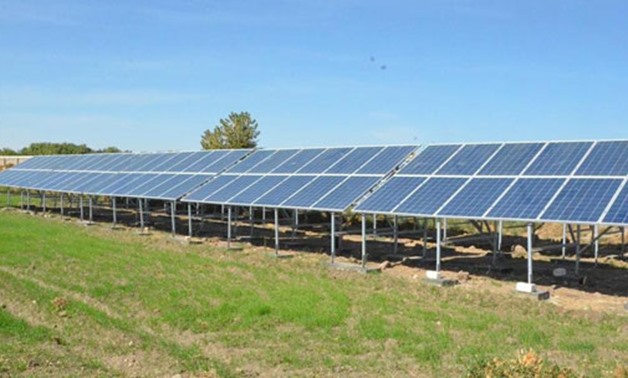CAIRO – 26 December 2018: Solar-powered irrigation has begun to be introduced to the agriculture in Egypt, a positive step toward developing the renewable energy industry.
In the past two days, a solar powered irrigation plant was inaugurated in Esna city, Luxor, to supply 42 acres with water.
 Solar-powered irrigation has begun to be introduced to the agriculture in Egypt, a positive step toward developing the renewable energy industry-Press Photo
Solar-powered irrigation has begun to be introduced to the agriculture in Egypt, a positive step toward developing the renewable energy industry-Press Photo
The solar powered irrigation plant is part of the Climate Changes project launched by the Executive Agency for Comprehensive Development Projects at Thomas 3 Village in Esna.
 Solar-powered irrigation has begun to be introduced to the agriculture in Egypt, a positive step toward developing the renewable energy industry-Press Photo
Solar-powered irrigation has begun to be introduced to the agriculture in Egypt, a positive step toward developing the renewable energy industry-Press Photo
Yousuf Galal, vice-president of the City Council of Esna, said the plant was established by the Arab Renewable Energy Company (ARECO) of the Arab Organization for Industrialization (AOI) as one of six solar powered irrigation plants in Sohag, Qena, Luxor and Aswan.
Galal added that farmers pay only LE 200 monthly for the plant, which runs from 6 a.m. to 5 p.m.
Egypt possesses a very high potential of utilizing solar energy, one of the highest in the MENA region. The introduction of solar powered pumps presents an opportunity to abandon non-sustainable and non-reliable fossil fuel powered generators.
In this regard, Othman el-Shaikh, project manager of the "Building Resilient Food Security Systems to Benefit the Southern Egypt Region", remarked that the solar powered irrigation plant built in Esna will limit the usage of fossil fuel in irrigation, especially that Luxor and Aswan are very sunny in summer and winter.
Shaikh remarked that costs of plant maintenance and management will be taken from the farmers.
Upper Egypt relies predominantly on agriculture. It accounts for 63 percent of the region's employment and contributes 40 percent of its rural income. Agriculture is also a source of income for 85 percent of the region's rural households; it is a sole source of income for 60 percent of its rural households.
Furthermore, it secures 40 percent of the region's food needs, according to statistics by report Green Climate Fund in August 2017.
In addition to its high prices, relying on fossil fuels has led to increasing the temperature in Egypt in general and Upper Egypt in particular due to climate change, as studies indicate that Upper Egypt's temperature will rise 1.5-2°C by 2040, 1.9-2.2°C and 3-3.5°C by 2060 and 2100, respectively.
This increase in temperature will result in many grave consequences, including 30 percent reduction in food production by 2040 as a result of reduced crop and livestock productivity, an increase in crop-water demand and an increase in pest and disease infestations.
Upper Egyptian farmers' productivity and food security are already negatively affected by climate change as the increasing temperature has destroyed up to 30 percent of their crops.
Additionally, irrigation water requirements have reportedly increased, and farmers have to increase the duration of irrigation from 5 hours to 7 hours per acre for most of their crops, leading to an increase in the costs of irrigation.
Egypt's average level of solar radiation is between 2,000 to 3,200kWh per square meter a year, but it has imported gas to operate electricity generating plants all over the country.
Implementing solar powered irrigation guarantees stable and reliable farm energy supply. Therewith, crop losses that result from insufficient irrigation are avoided, according to Energypedia.
Hence, several steps have been taken to depend on renewable energy such as Egypt’s present energy strategy which aims at increasing the share of renewable energy to 20 percent of Egypt’s energy by 2020.
The total installed capacity of solar photovoltaic (PV) systems in Egypt is around 10 MW for lighting, water pumping, wireless communications, cooling and commercial advertisements on highways.
In September, an agreement was enacted between Egypt and the Food and Agriculture Organization (FAO) on using solar-powered irrigation system in sites depending on underground water.
The agreement, which was signed on Oct. 19, 2017, was published in the official gazette Al-Waqa'i' al-Misriyya. As per Egypt’s 2014 Constitution, any agreement, loan or law shall be published in the official gazette to come into force.
The agreement is part of a project, via which the FAO will provide technical support to the governments of Egypt, Jordan, and Morocco, at a cost of $276,000.
Both Egypt and India started using the solar-powered systems in irrigation because it improves water governance, said the FAO in a report published on April 12. Cultivating the swathes of land in the desert via using underground water was one of the projects proposed to President Abdel Fatah al-Sisi in 2014. The government started using the eco-friendly solar-powered system of irrigation to pump water out of wells with low running cost.
This comes alongside with the action taken by the Ministry of Agriculture to respond to "the climate impact on agriculture in Upper Egypt, including the 'Building Resilient Food Security Systems to Benefit the Southern Egypt Region' Project, which launched in 2013," the report refers.
In collaboration with the World Food Program, this project aims to improve the adaptive capacity of Upper Egypt in the face of climate induced reduction in food production.
Further, it will help enhance livelihoods of vulnerable farms and rural communities in the face of climate change through cultivating climate-resilient crops and using efficient irrigation systems.



Comments
Leave a Comment